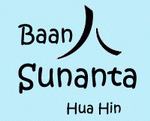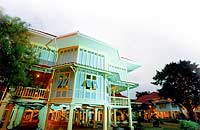
It had long been the tradition for Thai monarchs to build palaces in seaside towns for their summer retreats by the sea. The hill-top Nakhon Khiri Palace of King Mongkut, Rama IV, in Phetchaburi province, was where he stayed before travelling on to Tambon Wa Kor in Prachuab Khiri Khan province by boat to observe the total solar eclipse which he himself calculated.
King Chulalongkorn, Rama V, constructed Ban Puen Palace in Phetchaburi in the Western art deco style. King Vajiravudh had a palace built by Chao Samran beach in 1921, but when the flies from the nearby fishing community became too annoying, the king decided to uproot to a new location. Southern venues had been opened up due to the advent of the railway in 1896, and the Cha-am beachside area of Huay Sai offered the perfect solution, and Mrigadayavan Palace was built there. Klaikangwol Palace in Hua Hin was later built by King Prajadhipok.
"Upon arriving at the railway station, the king and his courtiers would travel onwards to the palace on horseback, while the queen and the inner court ladies were transported by ox-cart, except for Queen Rambhai Bharni of the seventh reign who was an accomplished horsewoman and always rode her favourite horse, Ruby," explained Thanpuying Putrie Viravaidya, deputy principal private secretary to His Majesty the King, recounting the tradition of the court's relocation to the beach during summer.
In addition to the buildings dismantled and transposed to the new locations, several new buildings were added following the king's own conceptualisation. The final architectural renderings were executed by Italian architect Ercole Manfredi from the Civil Works Department.
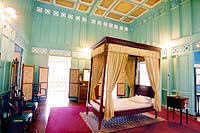
The raised living quarters rest on 1,080 concrete pillars, each with an inbuilt moat to prevent ants from climbing to the upper level and annoying the royal residents.
The palace complex is divided into three clusters of buildings.
The Sewakamart cluster comprises the Front Court for official functions, with the theatre, an audience hall, and an office for the Royal Aide-de-Camp.
Next is the Phisarn Sakorn cluster where the king's personal chambers are located. The Royal Suite contains a study, a bedroom, a dressing room and a bathroom, as well as a dining pavilion, and a Royal Bathing Pavilion.
Queen Indrasakdi Sachi took up residence with her inner court in the Samudra Biman cluster, which had its own dining pavilion and a bathing pavilion.
The royal family and their entourage would bring much of the furniture from Bangkok when they travelled to Mrigadayavan for the summer. The rest of the year, the rooms remained quite empty.
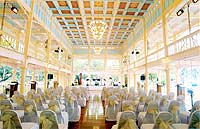
The various buildings were linked by covered corridors. The wooden floors were kept sparkling with a constant polish of banana leaf or pork rind, and when the king was in residence, the walkways would be lined with a red carpet.
It was at this palace that King Vajiravudh penned most of his literary works. On days when he did not have to perform any official function, the king would rise in the morning and proceed to his adjacent study overlooking the sea. The main desk, which still displays his writing instruments _ hand sharpened carpenter's pencils in a round container and writing paper with his personal insignia, now yellow with the passing of time _ was where he composed his work, while letters would be written at a smaller scroll desk nearby.
At approximately 2pm he would have lunch at Phisarn Sakhorn Hall in traditional Thai style. "He would be dressed casually in kui heng clothes [loose top and pants], and be seated on cushions on the carpeted floor," explained Thanpuying Putrie.
"Meals would be eaten with the fingers, and often the king's pet dogs would be waiting nearby to be fed scraps of food from the king's hands, after which ladies of the inner court would be ready with finger bowls. The colour of his napkins and handkerchiefs would follow the days of the week, a habit that HRH Princess Bejraratana still maintains to this day."
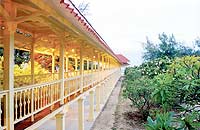
In the late afternoon, the king would often enjoy a game of badminton or cricket with his courtiers, or take a dip in the sea. He would access the beach along a long covered walkway towards the Bathing Pavilion, which had a changing room as well as reading room. "The cross atop the pavilion was used to display lights; yellow to indicate to courtiers that His Majesty was bathing, and green to indicate he was ready to leave the pavilion," explained Thanpuying Putrie. Women of the court would access the beach by a separate Bathing Pavilion that linked directly to the inner court buildings.
Almost every day, the pregnant Chao Chom Suvadhana would join him at the Royal Bathing Pavilion, where the king would coo to the baby in the womb, so happy was he to have an heir at last.
Every night, the king would dress up in formal tuxedo with tails, walk to Samudra Biman Hall where he would kiss Chao Chom Suvadhana on the cheeks, and escort her to the banquet hall for a Western-style dinner.
Plays would often be staged in the Samosorn Sewakamart Hall. "The objectives of the plays were not just purely entertainment purposes, but to educate the courtiers and indirectly plant the seed of patriotism," added Thanpuying Putrie.
King Vajiravudh was only able to enjoy the comfort of the summer palace twice, in 1924 and 1925, staying approximately two months each time. He passed away in 1925 at the age of 44. Since then, the palace remained deserted for decades. Only recently, the Mrigadayavan Summer Palace Foundation and the Department of Fine Arts joined forces to conserve and restore all the buildings to their present condition.
Today, a few pieces of the original furniture remain from the two royal visits. Some contemporary pieces have been added in the most important rooms to resemble as far as possible the original set-up during the royal visits. As such, visitors can gain an understanding of how the king and his court lived during their retreat at the summer palace.
The palace is open daily from 8:30am to 5pm.





